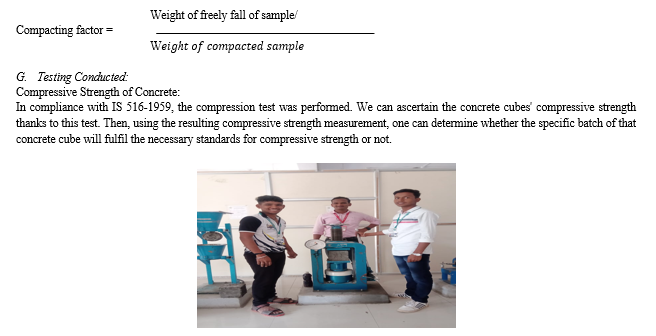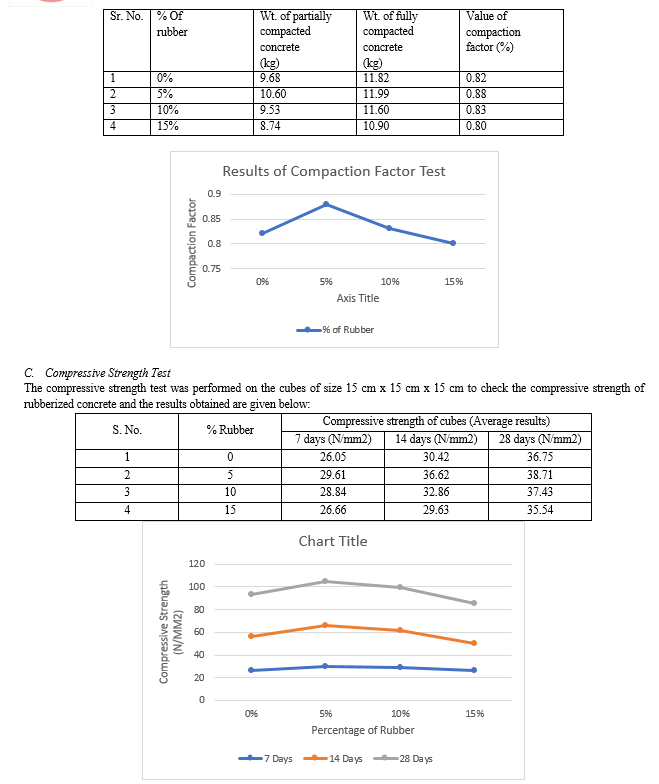Ijraset Journal For Research in Applied Science and Engineering Technology
- Home / Ijraset
- On This Page
- Abstract
- Introduction
- Conclusion
- References
- Copyright
Use Crumb Rubber Chips in Partial Substitution of Coarse Aggregate While Preparing Concrete
Authors: Ganesh K. Sarak, Rohit A Jadhav, SANDIP NIRMAL
DOI Link: https://doi.org/10.22214/ijraset.2024.58998
Certificate: View Certificate
Abstract
The purpose of this experimental investigation is to examine the behaviour features of rubberized concrete, which has coarse aggregate in place of some of the tyre rubber. Over 270 million scrap tyres are thought to be produced annually. One of the main problems in India is the disposal of discarded tyres in landfills, which is the responsibility of local governments and municipalities. Because it is not biodegradable, there are serious concerns to human health, the environment, and fire. The most promising uses of tyres in engineering are as aggregates for asphalt and concrete, artificial reefs, and erosion management, aside from gasoline obtained from tyres. Concrete\'s characteristics could be greatly improved in a variety of ways by using recycled tyre rubber as part of the aggregate. One of the most often used building materials is concrete. Because of this, the building sector is constantly looking for new applications and uses for its products, as well as ways to improve them while keeping costs down. The reference concrete specimen is made of M30 grade concrete. Rubber chips from scrap tyres have been utilised in place of traditional coarse aggregate as coarse aggregate. This will enable the efficient and widespread handling of rubber tyre waste in addition to enabling the sustainable use of the aggregates that are already accessible to us. After separating the rubber tyre waste into coarse chips, this tyre crumb aggregate is applied in increments of 5%, 10%, or 15% to replace the coarse aggregate. In order to determine the best way to employ crumb rubber as coarse aggregate in concrete, this study assessed the workability and compressive strength of rubberized concrete.
Introduction
I. INTRODUCTION
Every year, a staggering amount of worn rubber tyres accumulate worldwide, with around 180 million of them in the European Union and 275 million in India. Piling these tyres in landfills is one of the most common ways to get rid of this rubber trash, but we can't bury them there due to their low density and poor disintegration. These tyres are sometimes disposed of by just putting them in big holes in the ground or by placing them in a dump. Additionally, these dumps pay a big tribute to mosquitoes, which are known to spread numerous diseases and pose a major and dangerous risk to human health. The larger quantities of this rubber waste, however, can be used as bitumen, fuel, floor and roof coverings, pigment soot, etc. Rubberized concrete is one such use that might make good use of old rubber tyres. Granulated rubber crumbs generated from rubber waste can be used to make concrete more affordable by substituting a certain percentage of coarse aggregate. The technique known as continuous shredding can be used to produce granulated rubber crumbs that are small enough to successfully replace aggregates as coarse as gravel. Due to its superior resistance to frost and ice thawing, this type of concrete can be utilised in the construction of reinforced pavement and bridge constructions. The proper disposal of leftover tyre rubber is currently a major global waste management challenge. Globally, an estimated 1.2 billion trash tyres with rubber are produced annually. Additionally, it's estimated that 11% of tyres are exported after being used, 27% are illegally piled, stored, or dumped, and only 4% are used for civil engineering projects. In order to determine the potential of this waste tyre rubber in civil engineering projects, efforts have been performed. An added benefit of partially substituting rubber tyre aggregates in concrete is that it reduces the need for natural aggregates, which are getting harder to find for use in concrete manufacturing. In addition to being more workable than regular concrete, the waste tyre rubber combination can be used to create lightweight concrete (El-Gammal, 2010).
A. Crumb Rubber
The term "crumb rubber" refers to the rough rubber fragments extracted from car tyres. The method used to create this kind of rubber is known as ambient grinding. This multi-step method of grinding uses truck or vehicle tyres in the tread, sidewall, chip, or shred state. Rubbers, metals, and textiles are separated out in that order by following the method. The tyres are then reduced in size to smaller bits by passing them through a shredder. The tiny chips are subsequently fed into a granulator, which removes steel and fibre while breaking them down even more into even smaller pieces.
II. LITERATURE SURVEY
- Mohammed et al [1] In order to create early age concrete, this study will try to replace coarse aggregates with rubber waste. Rubberized concrete and rubber filler in concrete are the two types of concrete it performs. Rubbers were utilised in place of coarse aggregates and river sand as fine aggregate in rubberized concrete. For concrete filler, coarse aggregate often consists of crushed stone, gravel, or shredded rubber. The addition of waste tyre rubber aggregate, which functioned as voids in the matrix, was one of the factors that caused the rubberized concrete's compressive strength to decrease. This is a result of the weak link that exists between the concrete matrix and the rubber aggregate from used tyres. There will be a proportional drop in strength as the concrete's void content rises. The strength of Portland cement concrete is primarily influenced by the coarse aggregate's size, density, and hardness. The rubber partially replaces the aggregates, therefore the strength decrease makes sense.
- Mavroulido et al [2] It can be inferred that there is a sizable market for concrete goods in which adding rubber aggregate would be practical, even in spite of the observed lower values of the mechanical properties of concrete. These may also comprise applications of non-primary structural the medium-to-low strength needs while taking advantage of this concrete type's other advantages. Because there is such a huge global market for concrete goods, even if rubber tyre aggregate was utilised in concrete at very modest percentages, the amount of waste tyre rubber could be significantly decreased. Thus, the application of rubber aggregates from abandoned tyres in concrete has the potential to create a new pathway for worn tyres.
III. OBJECTIVES
The following are the work's targets:
- To create a mix design process for a mix with 30MPa.
- To investigate the effects of varying the percentages (0%–15%) of coarse-sized crumb rubber (20 mm–12.5 mm) added to the concrete mix before it is prepared.
- To use the compaction factor test and the slump test to assess the workability of freshly prepared concrete.
- To evaluate the cubes' compressive strength after 7, 14, and 28 days.
IV. EVALUATING PROGRAMME
A. Mix Design
The grade of concrete adopted for this paper M30
Material Quantity- (kg/m3)
Cement (grade 53)- 425.11
Fine aggregates- 651.14
Coarse aggregates- 1157.58
Water- 191.58
Water cement ratio- 0.45
The final mix proportions are:
Cement: fine aggregate: coarse aggregate = 1 : 1.53 : 2.72
B. Mixed Design Proportions for Rubberized Concrete
- In order to determine the compressive strength of concrete, 15 standard cubic specimens measuring 150 mm (nine samples for each percentage of crumb rubber) were cast and allowed to cure for seven, fourteen, and twenty-eight days. There were 36 cubes in all for the compressive strength test (9 cubes * 4 proportions).
- The mass of components needed will be determined based on a 10% waste assumption and nine cubes.
- Cube volume = 1.1*(0.15)3 = 0.0037125 m^3
|
MIX (%) |
CEMENT (kg) |
FA (kg) |
CA (kg) |
CRUMB RUBBER (kg) |
WATER (lit) |
|
0% |
1.57 |
2.41 |
4.30 |
0 |
0.711 |
|
5% |
4.08 |
0.221 |
|||
|
10% |
3.87 |
0.442 |
|||
|
15% |
3.620 |
0.615 |
C. Experimental Design
In essence, there are two main series in this test: the first was the standard concrete mixture, known as S1 mix, that had no coarse size rubber added to it. 5%, 10%, and 15% of coarse aggregate were added to or substituted in the second series S2. Coarse rubber by volume with defined concrete mix and coarse aggregates makes up 15% (S2-5, S2-10, S2-15). They decided to employ an M30 mix design with a 0.45 w/c water to cement ratio.
D. Specimen Preparation
The mix proportion of M30 was used to determine the weights of the cement, fine, and coarse aggregates.
Everything is well combined in a bay, and water is added at a ratio of 0.45. After a slow and thorough addition of water, homogeneity was attained. Any clumping or any balling that was discovered was removed, loosened, and then added back to the mixture. The modified rubber powder was added to the mixture in three different volumes of coarse aggregate—5%, 10%, and 15%—for the second series. Slump and compacting factor tests were performed on all of the concrete series mixtures immediately following mixing. A typical 150 x 150 x 150 mm cube Casts of the specimens were made. Immediately upon being placed in the mould, the specimens were coated with gunny to ensure total moisture retention. After being cast for 24 hours, the samples were stripped and placed in a water curing pond. A total of thirty-six 150 x 150 x 150 mm cube specimens were cast.
E. Curing
The ponding method of curing was used, and the resulting samples were cured for three, seven, and twenty-eight days.
F. Slump Test
which can be used at the workplace or in a laboratory. Using this procedure on extremely dry or damp concrete is not recommended. It doesn't assess every element that affects workability.
Is it consistently indicative of the concrete's palatability? Using this procedure on extremely dry or damp concrete is not recommended. Not every aspect that affects workability is measured.
The B.S:1882 PART2:1970 was followed in conducting the slump test.
Compacting factor test:
B.S. 1881: PART 2:1970 was followed in conducting the compacting factor test.
The compacting factor was computed using: -

For the compression test, the specimen’s cubes of 15 cm x 15 cm x 15 cm were prepared by using crumb rubber concrete as explained earlier. These specimens were tested under universal testing machine after 7 days and 28 days of curing. Load was applied gradually at the rate of 140kg/cm2 per minute till the specimens failed. Load at the failure was divided by area of specimen and this gave us the compressive strength of concrete for the given sample.
V. RESULTS AND DISCUSSIONS
The findings of many trials were achieved in accordance with the experimental programme. They are displayed in a graph or tabular format, which will be provided in this chapter.
A. Workability Test
The Slump test was performed on the rubberized concrete to check the work ability of it at
different replacements viz. 5 %, 10 %, 15% and the following results were obtained, according to which it can be concluded that with the increase in % of rubber from 0 to 15 %, workability decreases. Theoretical maximum value of Slump can be 100 to 175. The results obtained for Slump test are shown below:


Conclusion
1) The study approach has focused on using scrap tyres to reduce tyre waste and improve economic and environmental management. 2) Concrete that has a higher percentage of crumb rubber is less workable; that is, as the percentage of crumbed rubber increases, the workability of the concrete falls. 3) The 28-day rubberized concrete test findings indicate that a 5% to 10% replacement of rubber in coarse aggregate resulted in higher compressive strength compared to conventional concrete specimens with 0% rubber. 4) According to test results after 28 days, rubberized concrete with 5% to 10% more rubber in the coarse aggregate has a higher flexural strength than specimens of conventional concrete with 0% rubber. 5) It is impossible to avoid the strength drop with the inclusion of crumb rubber. These statistics, however, only offer approximate guidelines for the strength-loss of locally manufactured modified concrete relative to normal concrete with a specified strength of 30 MPa. 6) Rubberized concrete is also utilised for thermal and acoustic insulation. Thus, it can be utilised as a noise insulator in theatres, movie theatres, noise-proof rooms, auditoriums, and other spaces, as well as an insulating material for walls in residential and commercial buildings. 7) Additionally lightweight concrete is rubberized concrete. Every year, the number of motor vehicles in the globe grows at a rapid pace. Future products that can replace coarse aggregates are promised. Tyre recycling alternatives to coarse aggregate that benefit the preservation of the natural world. Decrease the usage of natural resources and increase the use of modified materials.
References
[1] Rubber Manufacturer’s Association, NW Suite 900, Washington DC 20005,2000. [2] Tantala, M.W., Lepore, J.A., and Zandi, I., “Quasi-elastic behavior of rubber included concrete”, Proceedings 12th International Conference on Solid Waste Technology and Management, Philadelphia, 1996. [3] Paul, J., Encyclopedia of polymer science and engineering, Vol. 14, 1985, pp. 787-802. [4] Takallou, H.B. and Takallou, m.B., Elastomeric, Vol. 123, 1991, pp.9. [5] O’Keefe, W., Power, Vol. 128, No. 10, October 1984, pp. 115. [6] Read, J., Dodson, T., and Thomas, J., “Experimental project – use of shredded tyres for lightweight fill, Oregan Department of Transportation, Post Construction report for Project No. DTFH -71-90-501-OR-11, Salem, Oregan, 1991 [7] Heitzman, M., “Design and Construction of Asphalt Paving Materials with Crumb Rubber”, Transportation Research Record No. 1339, Transportation Research Board, Washington DC, 1992. [8] Scrap Tyre Management Council, Scrap Tyres Use, Washington DC, 1995. [9] Esch, D. C., “Asphalt pavement modified with coarse rubber particles: Design, construction and ice control observations,” Alaska Department of Transportation and Public Facilities, 1984. [10] Adams, C., Lamborn, M., and Shuler, S., “Asphalt-rubber binder laboratory performance,” Report FHWA/TX-8571, 347-1F, Texas Department of Highways and Public Transportation, 1985. [11] Estakhri, C., “Use, availability and cost effectiveness of asphalt rubber in Texas, Research Report 1902 –1F, Texas Transportation Institute, Texas A&M University System, 1990. [12] Khosla, N.P. and Trogdon, J. T., “Use of ground rubber in asphalt paving mixtures,” Technical Report, Department of Civil Engineering, North Carolina State University, Raleigh, May 1990. [13] Raghvan, D., Huynh, H., and Ferraris, C.F., “Workability, mechanical properties and chemical stability of a recycled tyre rubber-filled cementitious composite,” Journal of Materials Science, Vol. 33, No. 7, pp. 1745-1752. [14] Khatib, Z.K. and Bayomy, F.M., “Rubberized Portland cement concrete,” Journal of Materials in Civil Engineering, 1999, pp. 206-213. [15] Fedroff, D., Ahmad, S., and Savas, B. Z., “Mechanical properties of concrete with ground waste tyre rubber,” Transportation Research Board, No. 1532, 1996, pp.66-72. [16] Ali, N.A., Amos, A.D., and Roberts, M., “Use of ground rubber tyres in Portland cement concrete,” Proceedings, International Conference on Concrete 2000, University of Dundee, UK, 1993, pp. 379-390.
Copyright
Copyright © 2024 Ganesh K. Sarak, Rohit A Jadhav, SANDIP NIRMAL. This is an open access article distributed under the Creative Commons Attribution License, which permits unrestricted use, distribution, and reproduction in any medium, provided the original work is properly cited.

Download Paper
Paper Id : IJRASET58998
Publish Date : 2024-03-13
ISSN : 2321-9653
Publisher Name : IJRASET
DOI Link : Click Here
 Submit Paper Online
Submit Paper Online

